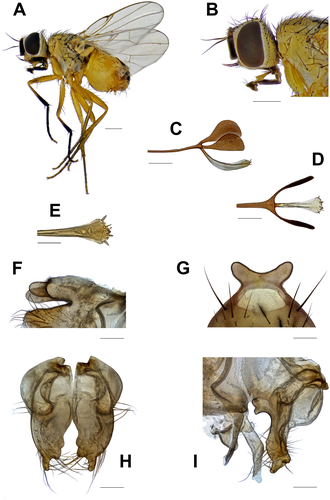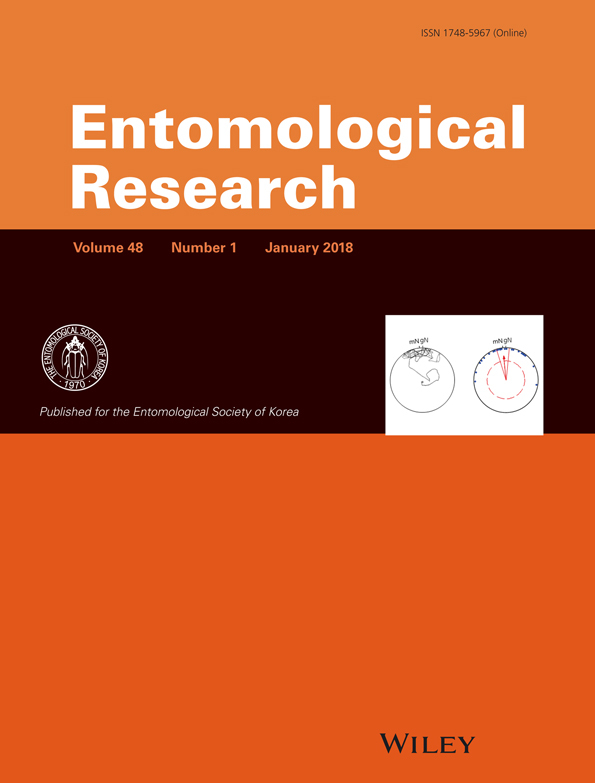First record of the quarantine pest Atherigona (Atherigona) oryzae Malloch (Diptera: Muscidae) in Korea
Abstract
Occurrence of the invasive quarantine pest fly, Atherigona (Atherigona) oryzae Malloch, is hereby recorded for the first time in Gyeongsangbuk-do Province, Korea. Morphological characteristics for accurate identification of the species, a list of hosts, and damage patterns are described to provide plant quarantine information for pest management.
Introduction
Atherigona (Atherigona) oryzae Malloch, commonly known by several names such as rice shoot fly, rice seedling maggot, or corn seedling maggot, has been designated as an invasive quarantine pest by the Animal and Plant Quarantine Agency of Korea (APQAK).
This fly is known to occur in most tropical and subtropical regions of Asia and Australia. In the Oriental region, this species is a serious pest of rice (Oryza sativa), maize (Zea mays), and wheat (Triticum aestivum). The larva cuts through the growing point of the seedling, commonly resulting in host death. Less severely damaged plants may recover; however, they show delayed maturity and reduced yield (Dale 1994; Pont & Magpayo 1995; Shinonaga 2003; Emden 2013; PKB 2017).
Therefore, annual revisions by APQAK (2014) have designated this fly as an invasive pest to be managed, to prevent possible pest inflow into the country and ensure the plant quarantine process. The APQAK aims to protect domestic agriculture and conserve nature, by controlling crop trade and transportation of plant material from overseas according to the plant quarantine law of Korea (Suh & Kwon 2016).
During a recently conducted field survey of the Diptera fauna in Korea, we recorded the occurrence of A. oryzae in Gyeongsangbuk-do Province, Korea. Following a taxonomic examination, we identified the species and confirmed this as the first recorded occurrence of A. oryzae in this country, to the best of our knowledge.
In addition, we recorded the occurrence of A. oryzae for the first time in Inner Mongolia, China, where we conducted a faunistic survey on insect diversity under a Korea–China joint project.
Materials and methods
To examine the taxonomic characters, distal abdominal or genital segments were removed with a pair of minute insect pins. For the dissection of genital structures, the isolated body parts were cleared with 10 % KOH. The genital segments were then mounted in glycerin jelly and observed with either a stereoscopic microscope (Olympus SZX 16, Olympus, Tokyo, Japan) or a compound microscope (Olympus BX50, Olympus). The specimens were photographed using an Olympus digital camera (DP 71, Olympus).
In addition, several field collections were carried out within Korea, using either sweep nets or light traps. The specimens examined in the present study are deposited in the collection of the School of Applied Biosciences, Kyungpook National University, Daegu, Korea.
Systematics
Atherigona oryzae Malloch 1925
Atherigona oryzae Malloch 1925: 117 (Coimbatore, India).
Atherigona samoaensis Malloch 1929: 159 (Safune, Savaii, Samoa).
Male
Head yellow in ground color; occiput darkened; frontal vitta dark brown to black, getting increasingly darker towards vertex; fronto-orbital plate, parafacialia, and cheek orange with light gray pollen; 1 reclinate fronto-orbital setae and 5–6 inclinate frontal setae present. Antenna dark brown to black; basal 2 antennal segments reddish brown; base of 3rd segment and arista reddish brown. Palpus reddish yellow and increasingly darker towards upper part. Prementum dark brown to black (Fig. 1A–B).

Thorax black in ground color with gray pollen, except for humeral callus, propleuron and tip of scutellum yellow. Presutural acrostichal setulae 2 or 3 rows. Pleuron with 2 strong and 1 fine proepisternal setae; 2–3 weak proepimeral setulae present. Basal lateral setulae of scutellum approximately a third as long as subbasal lateral setae.
Legs yellow. Coxae and trochanters yellow. Foreleg mainly yellow; femur and tibia increasingly darker towards tip, tarsus dark; femur with 1 preapical posteroventral seta. Mid and hind legs mainly yellow; tarsi dull yellow to brown; mid femur with 1 preapical posterodorsal seta; mid tibia with 1 posteroventral seta; hind tibia with 1 anteroventral and 1 posterodorsal setae.
Wing hyaline. Calypter whitish yellow and knob of halter milky.
Abdomen yellow in ground color. Tergites 1 + 2 and 5 unmarked; tergite 3 with a pair of dark elongate-triangular spots; tergite 4 with a pair of small round or rounded-triangular spots. Hypopygial prominence large and bifurcate (Fig. 1F–G). Trifoliate process strikingly expanded around middle; median piece slender and membranous (Fig. 1C–E).
-
- Body length
-
- : Male, 3.3–3.9 mm.
-
- Wing length
-
- : Male, 2.7–3.2 mm.
Material examined
[Korea] 2♂, Deoksan-ri,Buksam-eup,Chilgok-gun,Gyeongsangbuk-do, 6.IX.2015, SJ Suh; 5♂3♀, 9.IX.2015, locality and collector same as above; [China] 1♂1♀, Xiaojinggou Resort, Xincheng, Hohhot, Inner Mongolia, 25.VIII.2015, SJ Suh.
Distribution
Asia: Korea (South: new record), Japan (Honshu, Shikoku, Kyushu, Ryukyus, Ogasawara islands), China (Liaoning, Hebei, Henan, Jiangsu, Zhejiang, Shanghai, Hunan, Fujian, Guangdong, Hainan, and Inner Mongolia: new record), Bangladesh, Myanmar, Indonesia (Flores), India (Rajasthan, Delhi, West Bengal, Madhya Pradesh, Maharashtra, Bihar, Mysore, Kerala, and Tamil Nadu), Indonesia (Java, Sumatra, Lombok, Sulawesi, and Buru islands), Malaysia, Nepal, Pakistan, Papua New Guinea, the Philippines (Luzon, Palawan, Balabac, Leyte, Culion, Busuanga, Negros, Mindanao, and Sulu islands), Singapore, Sri Lanka, Taiwan, and Thailand. Oceania: Australia (Northern Territory, Queensland, New South Wales), Vanuatu, New Caledonia, Samoa, Tonga, and the Carolines (cf. Pont & Magpayo 1995; Lui 1996; Shinonaga 2003; EPPO Global Database 2017).
Hosts
Sprawling panicum (Brachiaria reptans), common turpentine grass (Cymbopogon caesius), Bermuda grass (Cynodon dactylon), southern crabgrass (Digitaria ciliaris), pangola grass (Digitaria decumbens), false couch grass (Digitaria longiflora), jungle rice (Echinochloa colona), delicate lovegrass (Eragrostis japonica), tropical cupgrass (Eriochloa procera), black speargrass (Heteropogon contortus), rice (Oryza sativa), barefoot panicgrass (Panicum psilopodium), ricegrass paspalum (Paspalum scrobiculatum), pearl millet (Pennisetum glaucum), yellow foxtail (Setaria pumila), sorghum (Sorghum bicolor), johnson grass (Sorghum halepense), habana oatgrass (Themeda quadrivalvis), wheat (Triticum aestivum), browntop millet (Urochloa ramosa), and maize (Zea mays) (cf. PKB 2017; EPPO Global Database 2017; Lucidcentral 2017).
Discussion and conclusion
Atherigona oryzae is commonly known as rice seedling maggot or corn seedling maggot. A wide range of graminaceous host-plants has been recorded through the Oriental region (Pont 1986; Pont & Magpayo 1995). In Australia, it has been observed on Digitaria decumbens (cf. Pont 1986). In India, its principal hosts are Digitaria ciliaris and Eragrostis japonica (cf. Pont & Magpayo 1995).
Atherigona oryzae infests mainly dry rice fields and occasionally, irrigated rice fields (Dale 1994; Emden 2013; PKB 2017). In the Philippines, it also infests maize seedlings, leading to approximately 10 % damage (Alolino & Catli 1988). In India, A. oryzae is a dominant tissue borer in young plants, with the larvae causing 0.79–3.23 % and 0.08–6.65 % dead heart in Annapurna and Jaya rice, respectively (Senapati & Satpathy 1983). Atherigona oryzae larvae feed on the central shoot of rice and corn seedlings by tunneling downwards and produce typical symptoms of twisted dead heart, wherein the central tiller of the seedling is dry. Unlike the damage caused by stem borers, the dried tiller is rotten at the base. The infested plants show discolored leaves with transparent patches of damaged tissue along the margins, become stunted, and may subsequently die. Larval feeding damages rice seedlings less than one month old and corn seedlings after emergence (Dale 1994; Lucidcentral 2017).
Hitherto, Atherigona has been treated as an alien taxon, which so far incorporates three pest species designated as the invasive quarantine pests by APQAK (2014) in Korea: A. orientalis Schiner, A. oryzae Malloch, and A. soccata Rondani. Among these three species, A. orientalis has been recently reported to occur in Korea by Suh and Kwon (2016) and A. oryzae is hereby reported for the first time in the Korean fauna, to the best of our knowledge. Even though damage to domestic crops by A. oryzae has not yet been reported in Korea, it may spread either to cultivated areas or into the wild, in the future. Therefore, it is of economic importance to thoroughly monitor the occurrence of this fly within Korea and undertake eradication measures to prevent disease outbreak and spread.
Moreover, the first record of this species in Inner Mongolia, China extends its northern limit of zoogeographical distribution and may contribute to revision of its quarantine pest status.




